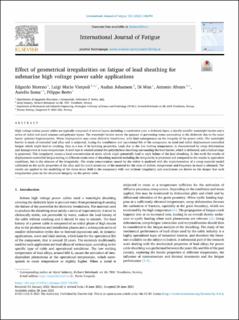| dc.contributor.author | Moreno, Edgardo | |
| dc.contributor.author | Viespoli, Luigi Mario | |
| dc.contributor.author | Johanson, Audun | |
| dc.contributor.author | Wan, Di | |
| dc.contributor.author | Alvaro, Antonio | |
| dc.contributor.author | Soma, Aurelio | |
| dc.contributor.author | Berto, Filippo | |
| dc.date.accessioned | 2021-08-16T06:46:33Z | |
| dc.date.available | 2021-08-16T06:46:33Z | |
| dc.date.created | 2021-06-25T14:42:31Z | |
| dc.date.issued | 2021 | |
| dc.identifier.issn | 0142-1123 | |
| dc.identifier.uri | https://hdl.handle.net/11250/2767862 | |
| dc.description.abstract | High voltage subsea power cables are typically composed of several layers, including: a conductive core, a dielectric layer, a ductile metallic watertight barrier and a series of radial and axial armours and polymer layers. The watertight barrier serves the purpose of preventing water permeating to the dielectric due to the outer layers' polymer hygroscopicity. Water impregnation may cause dielectric breakdown, with fatal consequences on the integrity of the power cable. The watertight barrier is made of extruded lead alloy and is subjected, during the installation and operational life of the component, to axial and radial displacement-controlled fatigue which might lead to cracking, thus to a loss of its isolating properties. Lead, due to the low melting temperature, is characterized by creep deformation and damage even at room temperature. A steel tape is winded around the polyethylene sheathing surrounding the lead barrier, which is deformed, and a helical ridge is generated. This irregularity causes a local concentration of strain which might potentially lead to early failure of the lead sheathing. In this work the results of displacement-controlled fatigue testing at different strain rates of sheathing material including the irregularity is presented and compared to the results in equivalent conditions, but in the absence of the irregularity. The strain concentration caused by the defect is analysed with the implementation of a creep material model calibrated on the cyclic properties of the alloy and the notch sensitivity of the material for the class of defects, temperature and frequency in exam is obtained. The results are applied to the modelling of the stress-strain field in the component with and without irregularity and conclusions are drawn on the danger that such irregularities pose on the structural integrity on the power cable. | en_US |
| dc.language.iso | eng | en_US |
| dc.publisher | Elsevier | en_US |
| dc.rights | Navngivelse 4.0 Internasjonal | * |
| dc.rights.uri | http://creativecommons.org/licenses/by/4.0/deed.no | * |
| dc.title | Effect of Geometrical Irregularities on Fatigue of Lead Sheathing for Submarine High Voltage Power Cable Applications | en_US |
| dc.type | Peer reviewed | en_US |
| dc.type | Journal article | en_US |
| dc.description.version | publishedVersion | en_US |
| dc.rights.holder | © 2021 The Author(s). Published by Elsevier Ltd. This is an open access article under the CC BY license (http://creativecommons.org/licenses/by/4.0/). | en_US |
| dc.source.pagenumber | 12 | en_US |
| dc.source.volume | 151 | en_US |
| dc.source.journal | International Journal of Fatigue | en_US |
| dc.identifier.doi | 10.1016/j.ijfatigue.2021.106399 | |
| dc.identifier.cristin | 1918564 | |
| dc.relation.project | Norges forskningsråd 256367 | en_US |
| dc.source.articlenumber | 106399 | en_US |
| cristin.ispublished | false | |
| cristin.fulltext | postprint | |
| cristin.qualitycode | 2 | |

